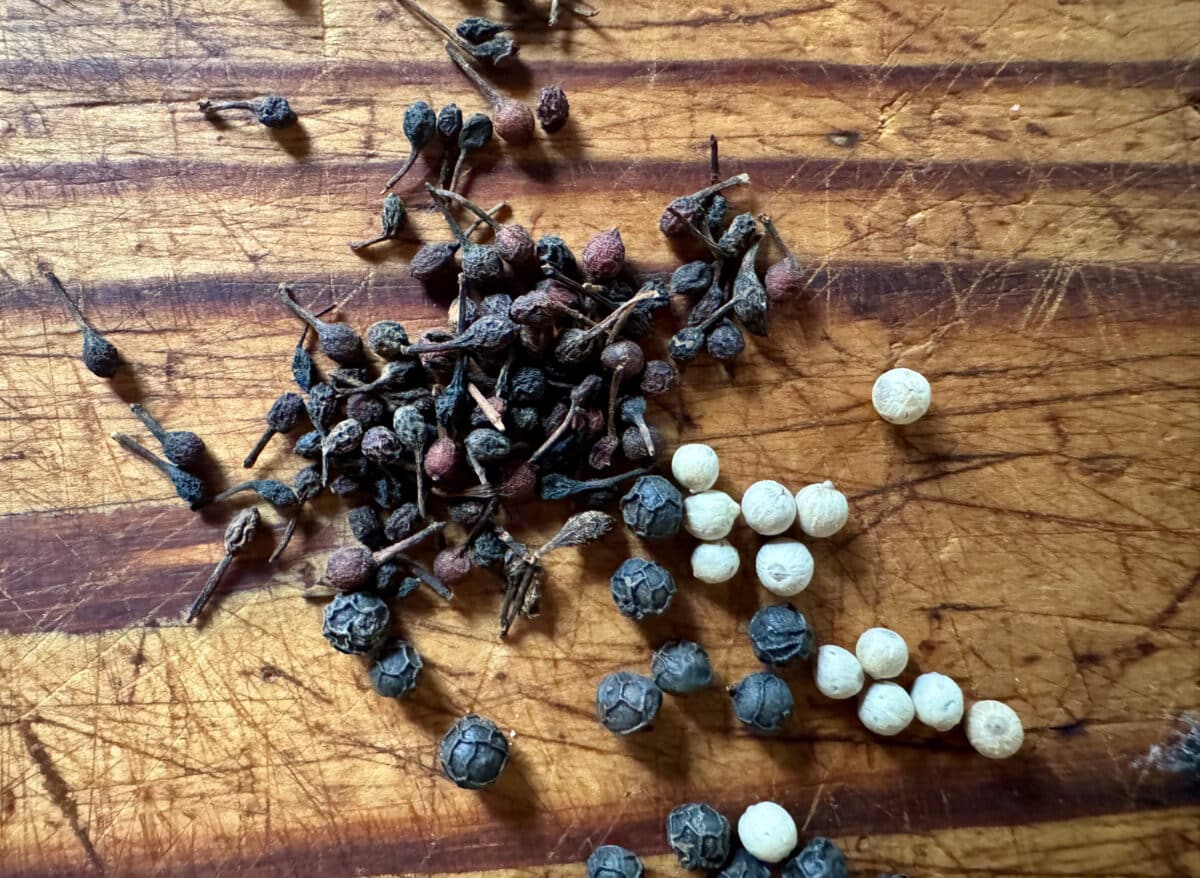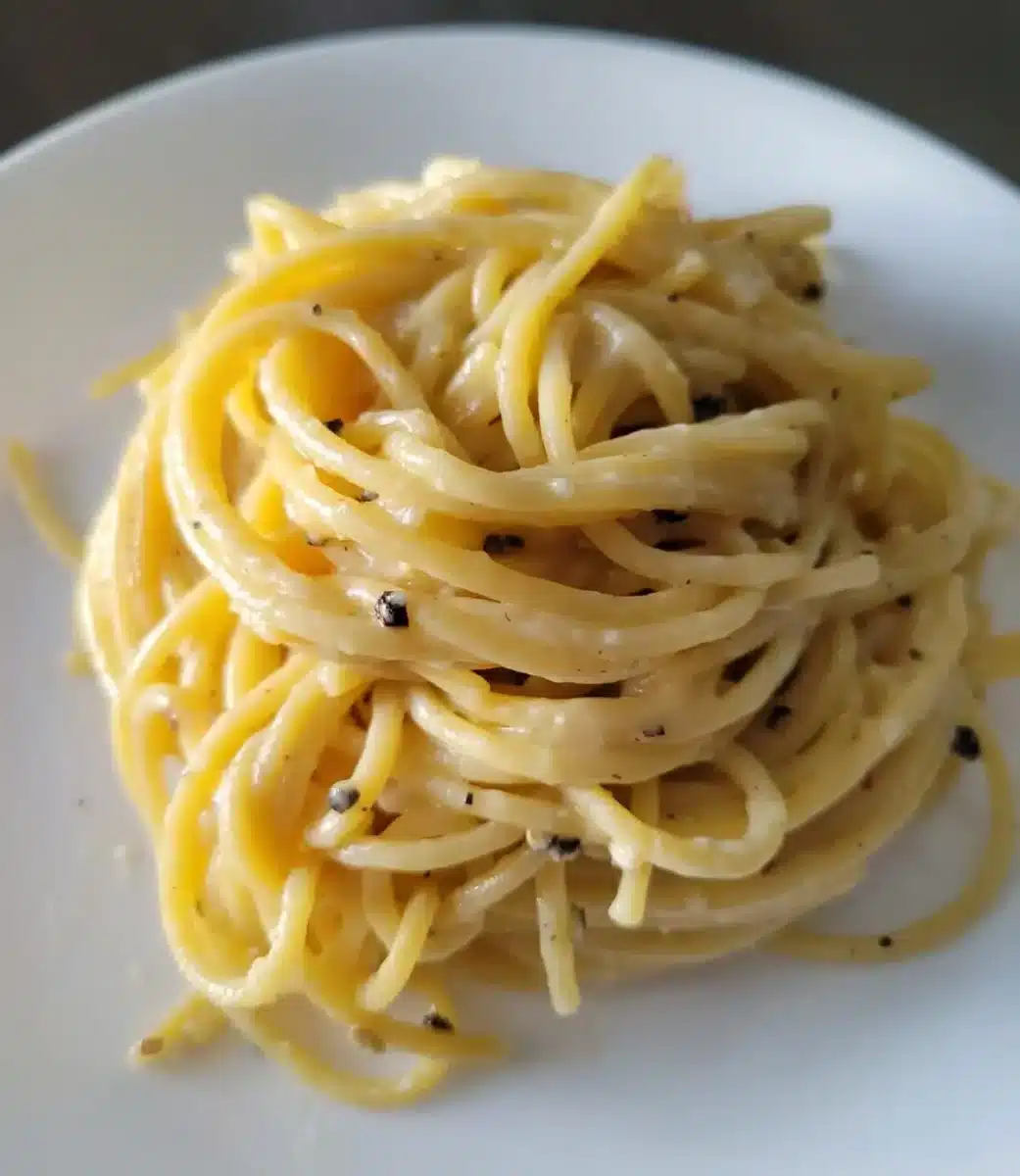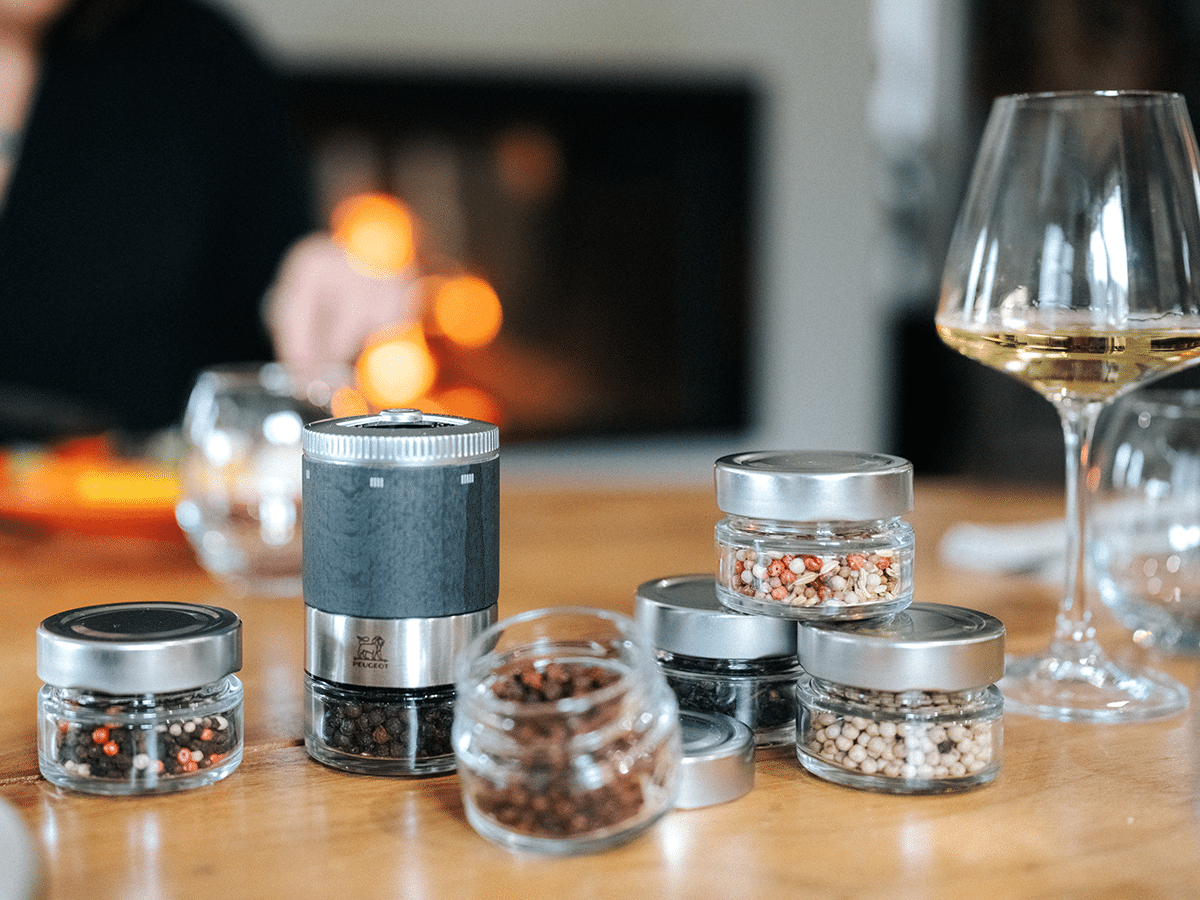In the symphony of flavors that grace our kitchens, the peppermill often stands silently by while other spices get the applause.
All black peppercorns are not the same!
Just because one black peppercorn might look like another, don’t be fooled into thinking they’re all alike! Where it’s grown and who you buy it from make a world of difference. In fact, just like wine, pepper has terroir—a taste of the place it was grown. Each variety of pepper has its own unique flavor as a result of its environment, when it was harvested, and how it was processed.
It’s safe to assume that most home cooks have a peppermill in their home at the ready, usually paired with a saltshaker or grinder. But is yours filled with non-descript supermarket peppercorns? We all cook with pepper, but how many of us consider the vast range of flavors that different peppercorns can offer to our food?
It’s time to challenge your pepper perceptions and your taste buds.
Every good cook knows the importance of trying new tastes and combinations. Pepper is an affordable spice (it’s not out of reach like fine wine, saffron or caviar) so it is fun and rewarding to stock a pantry with a varied selection of peppercorns. The coarseness of the grind affects the flavor as well. Just as cooking is a communal activity, so can sharing and comparing be an activity that brings food, family, and friends together. Once you taste various peppers, you will find that it’s not about the heat, but rather, the flavor.
And now, the peppercorn challenge awaits.
Just as olive oil from Italy is very different from olive oil from Greece or California, peppercorns are first distinguished by their place of origin, and then by their characteristics.
To appreciate the wide variety of peppercorns, look for peppers from around the world and put them to the taste test in your cooking. Tan Hoi is a pepper harvested in Vietnam with a warm, woody profile that delivers a quick and intense burst of heat. Nepalese Timut peppercorns deliver a surprisingly tangy flavor and vibrant citrus notes. To understand what peppercorns can do for your cooking, taste them and experiment.

The daily grind
When we dine out we expect our server to offer a few grinds of pepper for our Caesar salad or plate of pasta. This practice has become commonplace, but it wasn’t always so.
When pepper was imported by the British to colonial America, it was an essential kitchen ingredient, for both seasoning and health. The antimicrobial property of pepper kept food fresh. Peppercorns were ground by hand, usually in a mortar and pestle and used in both savory and sweet recipes.
Culinary historian Sarah Lohman has written extensively about pepper in her book Eight Flavors (Simon & Schuster 2016). She explains that the first modern home pepper grinders became available in 1874 when Peugeot, a manufacturer of coffee grinders, applied the same technology to grind pepper. Their device fed peppercorns into a rotary mill that could be adjusted by turning a nut for a fine or coarse grind. But despite this clever labor-saving device, by the end of the nineteenth century many home cooks purchased boxes of pre-ground pepper.
In the book Pepper: A Guide To The World’s Most Famous Spice (Rowman & Littlefield 2018) author Joe Barth tells us that often the peppercorns used to make pre-ground pepper (that black dust that comes in flimsy tins) are of low quality and may be adulterated with other ingredients. Often pre-ground pepper is old even before it’s ground, which leads to a loss of flavor and aroma.
Freshly ground black pepper was a luxury specialty item for several decades. In the 1980s, Chef-owner Edward Bottone of Bistro Lautrec in Philadelphia added to the cachet of his upscale French restaurant by setting wooden Peugeot mills on each white tablecloth. (He regularly replaced them as patrons slipped the “gourmet” gadget into coat pockets.) A revival of the popularity of freshly ground pepper happened in the 1990s when America watched celebrity chefs use pepper mills on TV. Sarah Lohman writes that black pepper consumption has increased by 40% in the two decades since the Food Network was launched.

Cacio e Pepe is a perfect test
A tasty bucatini with cheese and pepper is extremely easy to make, with just three ingredients: cheese, pepper, and pasta (a fourth, butter, is optional). A dish this simple relies on the exceptional quality of the seasonings—in this case, it’s black pepper, so a great opportunity to taste and choose from a selection of peppercorns. Oddly enough, many recipes call indiscriminately for “pepper” without a nod to the diversity of varieties available. Set out at least two small tasting bowls with a few grinds of peppercorns in each, and let your guests select while the water boils for the pasta. A quick finger dip in each bowl, with a palate cleanser of bread between each, will make for lively conversation. The dish is quick to prepare, and it needs to be served immediately—a fun tasting gets everyone involved in the total culinary experience.
In this recipe the freshly ground black pepper adds a warm depth of flavor that balances the richness of the cheese. Cacio e Pepe is a testament to the Italian culinary philosophy of using few, high-quality ingredients to create a dish that is greater than the sum of its parts.
Cacio e Pepe is a perfect test
A tasty bucatini with cheese and pepper is extremely easy to make, with just three ingredients. Cheese and Pepper, on pasta, (if you don’t count water, and salt. Butter is optional) A dish this simple relies on the exceptional quality of the seasonings—in this case, it’s black pepper, so a perfect opportunity to taste and choose from a selection of peppercorns. Oddly enough, many recipes call indiscriminately for “pepper” without a nod to the diversity of varieties available. Set out at least two small tasting bowls with a few grinds of peppercorns in each, and let your guests select while the water boils for the pasta. A quick finger dip in each bowl, with a palate cleanser of bread and/or wine between each will make for lively conversation. The dish is quick to prepare, and it needs to be served immediately—a fun tasting gets everyone involved in the total culinary experience.
For centuries pepper has been the most important spice in the world.
By volume it is the most desired, accounting for around 30% of the world’s spice trade. Historically it’s been the most coveted, both because it can help to preserve food and because its flavor both complements and enhances flavors its paired with. Some of our favorites:
Voatsiperifery Wild Pepper is a rare find from the forests of Madagascar. It’s not cultivated but rather harvested from wild pepper vines that grow high in the trees. These peppercorns are smaller and have a tail, leading to their nickname “tail pepper.” With a flavor that is both earthy and slightly sweet, with a hint of citrus and floral undertones, Voatsiperifery pepper is a culinary treasure, best used whole in slow-cooked dishes or ground fresh over a finished plate to preserve its delicate aroma.
Kampot Pepper, prized for its unique flavor and aroma, comes from the province of Kampot in Cambodia. The mineral-rich soil and humid sea climate impart a flavor that is simultaneously intense and delicate with hints of eucalyptus and lime. Kampot pepper elevates the taste of seafood and can be a surprising twist to desserts like chocolate and strawberries.

It's time to awaken your palate to a world where not all black peppercorns are created equal.
Wayanad Black Peppercorns, hailing from the lush Wayanad district of Kerala, India, are renowned for their robust and intense flavor. These peppercorns are harvested at the optimal stage of ripeness, ensuring a potent, spicy heat that is deeply embedded in each grain. Wayanad’s unique climate and rich soil contribute to the development of a distinct earthy aroma and a complex taste profile, marked by subtle hints of woodiness and a lingering warmth. Preferred by chefs worldwide, these peppercorns excel in enhancing the depth of flavor in a wide range of dishes, from classic meat preparations to innovative vegetarian creations, infusing them with a signature piquancy that elevates the culinary experience.
Sikara White Pepper comes from the same vine as black pepper but is allowed to fully ripen before the skins are removed, leaving the seed. The result is a pepper with a smoother, less complex flavor than its black counterpart but with a characteristic heat that builds slowly. Its subtle flavor is preferred for use in white sauces and lighter dishes, such as fish, chicken, and potatoes, where you want the peppery bite without the black specks.
Tellicherry Pepper, selected from the largest berries on the vine, Tellicherry peppercorns are left longer to mature, which allows them to develop a deep, complex flavor. Originating from the same Indian coast as their Malabar counterparts, these peppercorns have a pungent fragrance and a spiciness that lingers, making them a favorite for grinding fresh onto salads and steaks.
Sarawak Pepper is cultivated on the island of Borneo in Malaysia, known for its clean, sharp piquancy and a slight woodiness. It’s less intense than other peppercorns, which makes it versatile for a wide range of cuisines. Ground Sarawak pepper is particularly suited for poultry dishes and lighter sauces where it adds depth without overwhelming the palate.
Pink Peppercorns, despite their name, are not true peppercorns but the dried berries of the Baies rose plant. They have a delicate, fruity flavor with a mild peppery heat and a touch of sweetness. Their vibrant color and subtle flavor make them an excellent choice for color-sensitive dishes like fish and cream sauces or as an attractive garnish on pastries and salads.
Red and Purple Peppercorns are the fully matured versions of the green and black varieties. They offer a rich, bold flavor that is less pungent but more complex than black pepper, with a fruity note that is almost wine-like. These rare peppercorns are a gourmet delight, ideal for special occasions, and can be freshly ground over dishes such as grilled meats and ripe cheeses to enhance their natural flavors.


In the symphony of flavors that grace our kitchens, the peppermill often stands silently, filled with generic, nondescript peppercorns from the local supermarket. But here’s a tantalizing thought—what if your pepper grinder could be a passport to a world of taste sensations? Step into the universe where all black peppercorns are not created equal, and embark on a culinary exploration that challenges and delights your taste buds. ![]()
In Partnership with Peugeot Saveurs
